There is nothing more fundamental in photography than establishing a point of view. Point of view in photography refers to the position of the camera when taking a picture. If the camera low to the ground this is a “worm’s eye view”. If the camera higher up and pointed straight down this is a “bird’s eye perspective”. Although this concept is simple enough, both beginner and more advanced photographers often fail to establish a point of view for nature that coincides with how they personally view the world. Putting ones heart and soul into a photograph to create a unique image requires a personally expressive point of view.
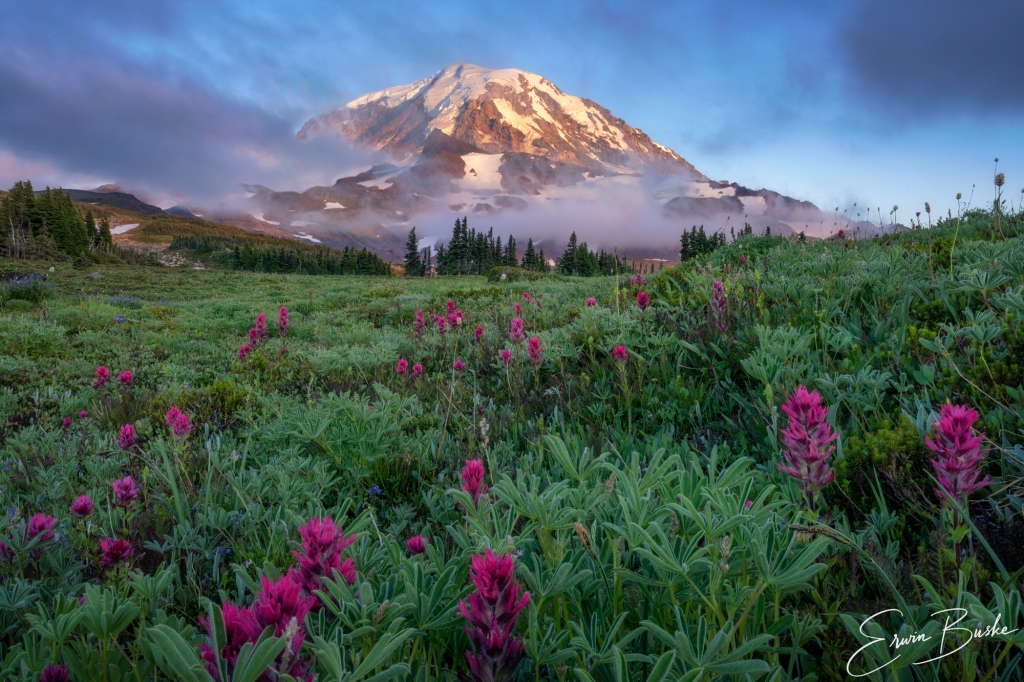
Magenta Paint Brushes in the Mountain Meadow
This image is a good example of a “Worm’s Eye” point of view.
Establishing a personally expressive point of view requires what I call “working the area”. Before even taking out the large interchangeable lens camera, one must explore a wide range of points of view. Go low, go high, get near, move further back, go left, go right-in short dance around to find the best vantage point for your subject. A cell phone camera is also a great tool for establishing a point of view, one which I now almost always use because it is so intuitive and allows me to explore many options quickly. A slow approach to photography does not mean not moving around and even in a go slow approach moving around and working the area should be done fairly quickly in order to explore a wide range of options. The biggest mistake I see photographers, both beginner and advanced, doing is not moving around and exploring options. No matter how good you get, you still need to do this! What I typically see in Landscape Photography even among advanced photographers is getting to a scene and immediately establishing a point of view planting their tripod legs-big mistake. No one is that good! Your legs need to work, you need to dance! I am currently mentoring a beginner Highschool student and point of view is one of the first concepts I taught him. He quickly understood the concept and carried out an assignment to develop multiple points of view. The impact on his growth as a creative photographer was immediate and easy to see in his images.
One should establish a point of view before deciding upon an angle view. The angle of view is determined by the lens focal length. Wide angle lens have a wide angle of view. Telephoto lenses have a narrow angle of view. The temptation is to first start with an angle of view then establish a point of view, but in my experience this approach leads to more formulaic rather than creative images. Once a good point of view is identified, then and only then should one decide which angle of view (lens focal length) works best to best present the point of view. The over reliance on either the wide angle or telephoto perspective usually is a result of jumping immediately to one of these two lens choices without first establishing a personally expressive point of view by working the area. The wide angle or telephoto may indeed be the best choice for some points of view, but for many others it will be something in the standard focal length range, 30mm to 70mm in full frame photography. Once you get in the practice of first establishing a point of view, you might find out that on some trips that a majority of your images will actually fall in the often ignored standard focal length range.
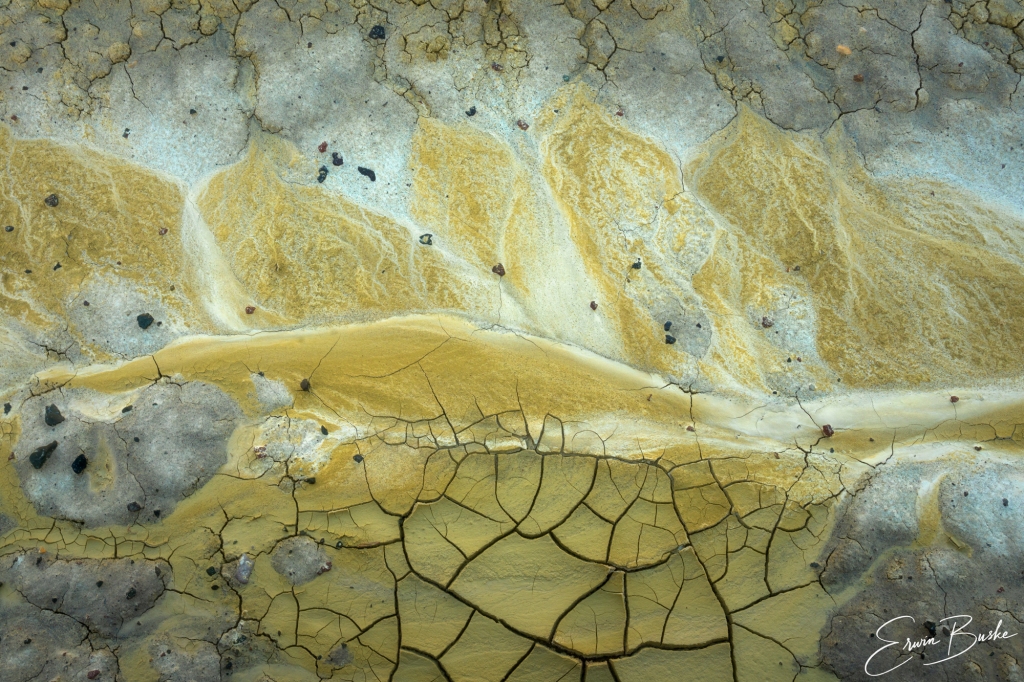
Painted Hills Claystone Silt Abstract: 32mm, F14, 1/60, ISO 400 Handheld
This is a good example of a “Bird’s Eye” point of view looking straight down.
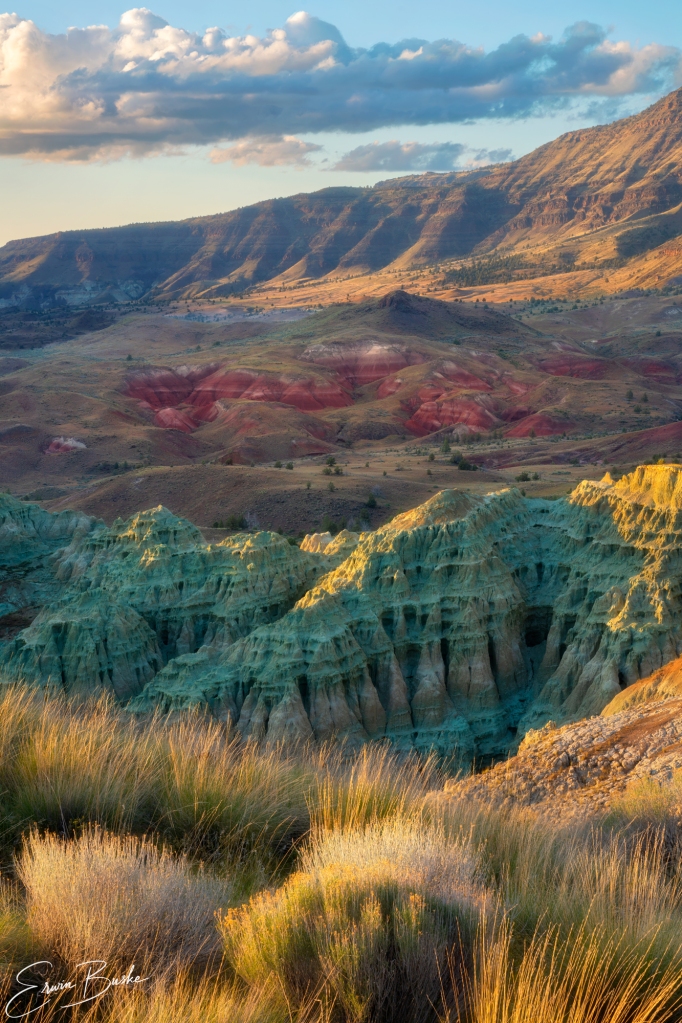
Spirits of our Ancestors: Painted Hills
72mm, F14, 1/20, ISO 100, 2 image focus stack
Although this image has a near far perspective it was not taken with a wide angle lens but rather with a 70-200 telephoto zoom at 72mm. I first established a point of view by working this area for about an hour before settling on this composition. The layering you see in this image, of not only the grassy foreground but also the turquoise peaks and red painted hill like mounds, could only be achieved using a moderate telephoto focal length. The grassy foreground was the most tricky in this image and it required a low point of view fairly far back from the grass and focus stacking to get the entire image sharp.
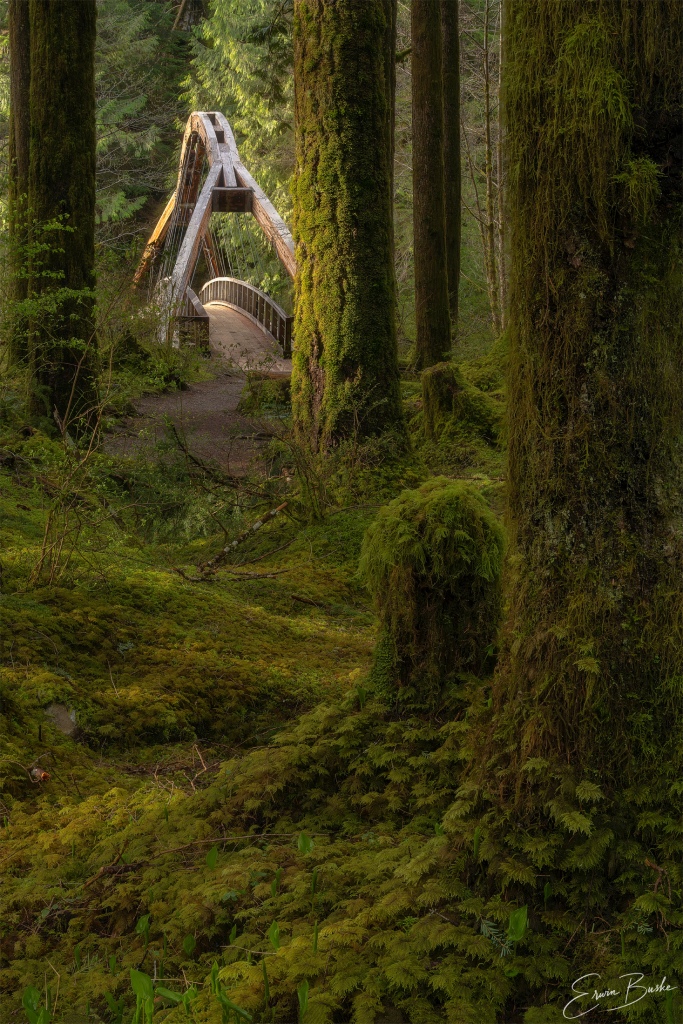
Middle Fork Bridge to the Spirit of the Shire:
70MM, F14, 1/2S, ISO 100, Focus Stack
I discovered the point of view for this image by getting very low to the ground and making multiple dance moves forward and back, left and right, looking for the vantage point that would provide the best visual flow from the moss to the tree trucks and bridge. Once settling on this point of view, I decided it would work best with a 70mm moderate telephoto perspective to achieve a good balance between a near far perspective and compression of key elements in the scene. A 70mm telephoto would also render the bridge at a size that would draw the eye into the light shining on the bridge through the trees and the middle fork river basin.

Day of the Eagle 347mm, F11, 1/2000, ISO 1250 Handheld
The point of view for this image is looking more or less strait up which allowed me to photograph the textures on the underside of the eagle’s spread-out wings. In order to render the bird at a sufficient size in the frame I used my 200-600 zoom lens.

Trilliums Underneath Big Cedar Tree 18mm, F16, 1/5, ISO 400 Focus Stack
The point of view for this image is a worms eye view and up close to the trilliums but also looking almost straight up to the big tree in the distance. It might look easy but it took some doing to get this point of view. Although I tried this with a much wider focal length I found 18mm offered a less distorted and more realistic rendering of the scene, much as if one were lying on the forest floor and looking up at the trilliums and big cedar tree.
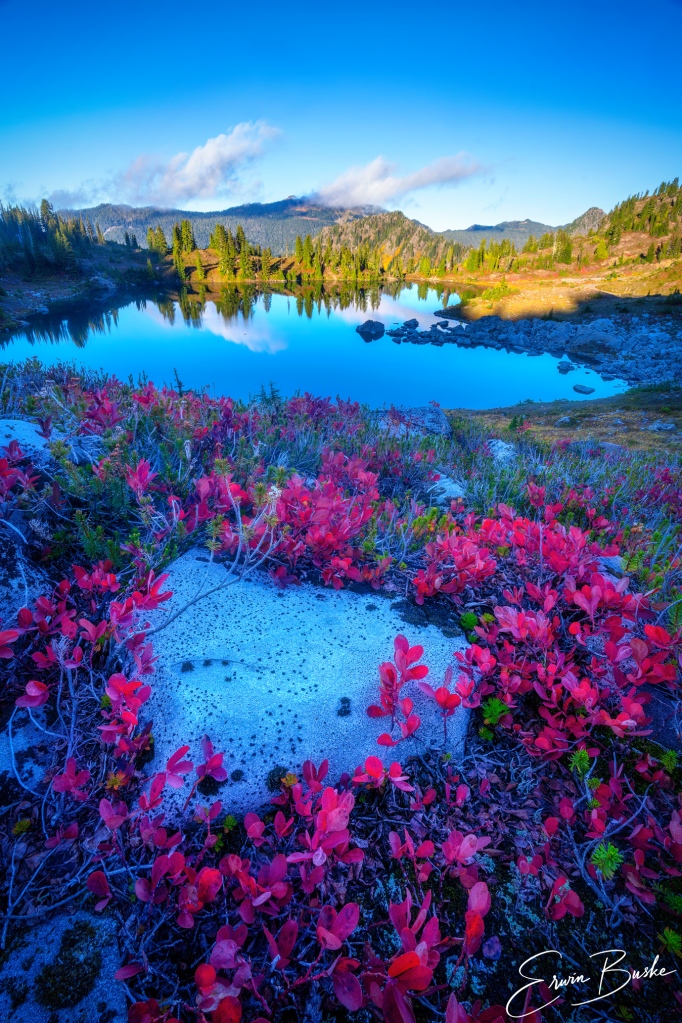
Two Hearts Beat As One: 16mm, F14, 1/10, ISO 100 Focus Stack
Olympic National Park
This is Lunch Lake in the Seven Lakes Basin of Olympic National Park. This lake from most points of view does not look like a heart but from this point of view it does. Note there is another lake in the basin called Heart Lake that more obviously looks like a heart from any point of view. Point of view often also involves juxtaposition. Juxtaposition is often not easy to find and involves both a keen eye and much moving around and working the area. The rock in the foreground and surrounding red huckleberries echoes the heart shape of the lake. In nature all hearts beat as one.
Know Thy Self
Although the concept of a Point of View is simple enough, it is where you place your camera, many people find it challenging to create a personally expressive Point of View. To create an image that is personally expressive, a person needs to first be aware of how nature and the landscape makes them feel at a more emotional level. This might seem simple enough also, but I have found through my work with multiple students, few (at least initially) have this ability. It is not quite the same as the thoughts and feelings you bring with you when you visit a landscape. It is the feelings, emotions and moods that flow from your immediate and moment by moment connection to nature and the landscape.

Comfortably Lost in the Middle Fork Forest
I have found that the best way to get in touch with what you are feeling when in nature is to spend at least some time daily walking through nature ironically without a camera in hand. Doing this daily will help you move toward a more meditative state of mind, also known as the “Beginners Mind” in Zen. The “Beginners Mind” is free from preconceived notions about a place and our normal preoccupations with daily concerns. This opens the door to a more immediate connection to the nature and the landscape. Freed from the filters of the mind, one is more open to immediate flashes of perception and seeing things that others likely pass by. This is because you will be connecting directly with nature, nature in you, you in nature, no separation.
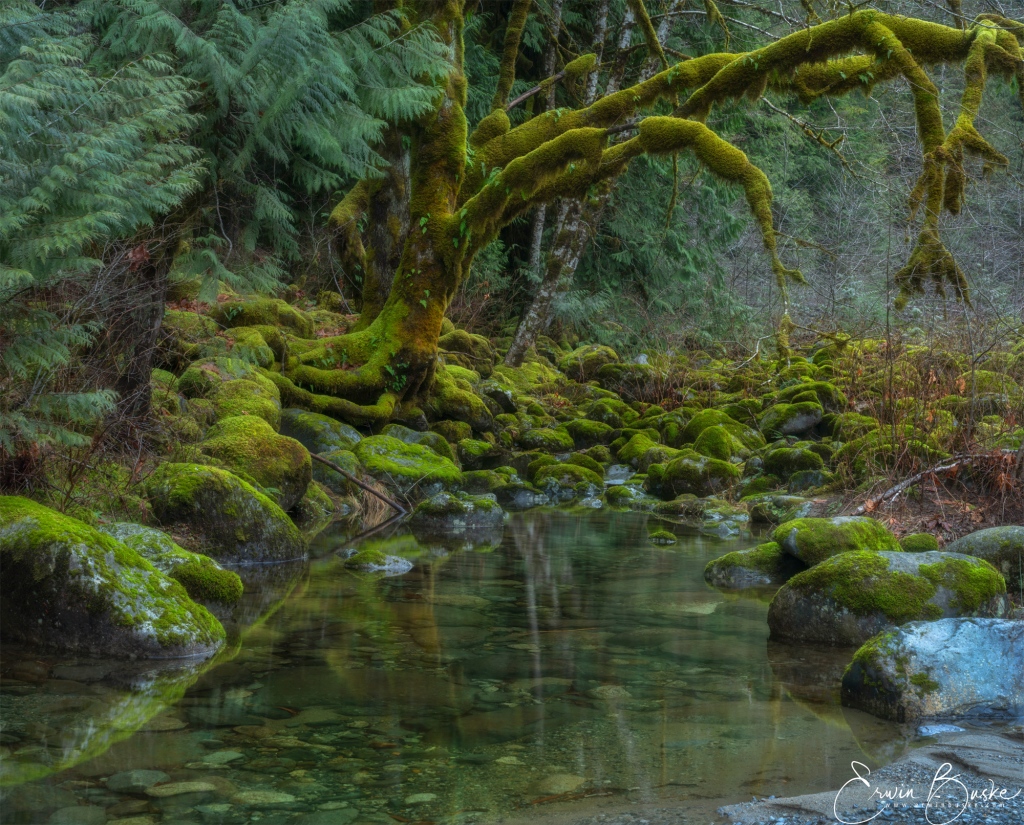
Forest Pond Mossy Stones
While hiking through the Middle Fork forest I came upon this small pond surround by lush mossy stones. To me, although not grandiose in its beauty, it was such beautiful sight to behold on a Mid Winter day. Several people reached out to me on Social Media wanting to know exactly where this scene is located. I declined to tell them as I know that scenes like this can only be found through becoming more self aware and in tune with one’s surroundings, not be retracing someone else’s steps.
What About Intentions?
Some of you may be wondering is there a place for intentions when establishing a personal point of view that requires getting back to a more beginners state of mind and letting go of expectations. My answer is that there is still a place for intensions. One should always start out with a set of intensions. To do otherwise is a bit like setting out on a boating trip with no ability to stir the ship. Having intentions is not the problem, the problem is not being open to changing plans once circumstances change. In the movie “Get Back”, during the creative recording sessions where the Beatles were engaged in a very free flowing and iterative process of composing their songs, Paul McCarthy says to his band mates that entering a session with no plan is a recipe for getting absolutely nothing done. This is interesting that he would say this because there was an incredible amount of improvisation and changing of plans in those jam sessions associated with the songs on the Get Back film set. The songs that were eventually recorded bore little resemblance to the original ideas and plans. Creative photography follows a similar trajectory. One is far more likely to be creative if one starts off with a set of intensions, but at the same time feels an immediate connection to nature, and is willing to pivot with what is happing in the field and momentary flashes of new perception. Can you imagine trying to write an essay or a story without a outline? Can you imagine the creators of the movie Avatar attempting to make a movie without a script or a plan? Of course not. Plans are not the problem and are necessary. The problem is not being flexible and willing to pivot and change the plan.
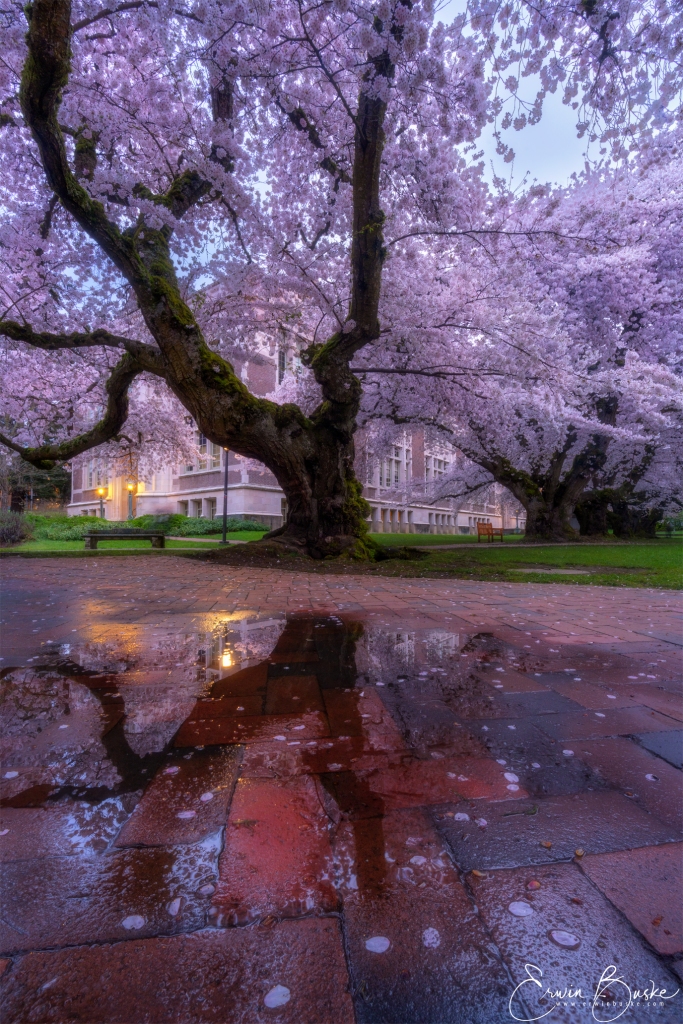
Cherry Blossoms Cobble Stone Roots
This old gnarled Cherry Tree, with its beautiful blossoms, also looked a bit spooky in the light of the early morning, also collecting some warm light from the golden lamps. Standing contorted and strong, as if it was doing a kind of yoga tree pose, its reflection to me looked almost like its own roots anchored deep deep in the ground. When I arrived at the UW Quad on this early morning, this is not the image I had planned. But when I realized that hoards of people were standing in the way of my originally planned compositions, I looked with fresh eyes in areas where few people were present. When I saw this magnificent tree, I knew this was the image and story for this day!
Technique: Learn it to Forget It
In a sense having a plan and the ability to be spontaneous both aim for the same thing. Both help free our mind from an overly deliberate and analytic approach to photography and allow us to shoot more from the heart which is the key to being creative. Because the plan is already there we do not need to think about it all that much in field. And because we are spontaneous we also do not need to think all that much about the need to change direction. Even higher levels of freedom are possible by being so thoroughly knowledgeable about photographic technique that it also becomes second nature. As important as things like aperture, shutter speed, and ISO are, we should not have to think about them all that much in the field. At this point in my photographic journey, I dial them in manually with no thought at all. This frees me to follow my heart mind finding that point of view that supports best my creative vision.
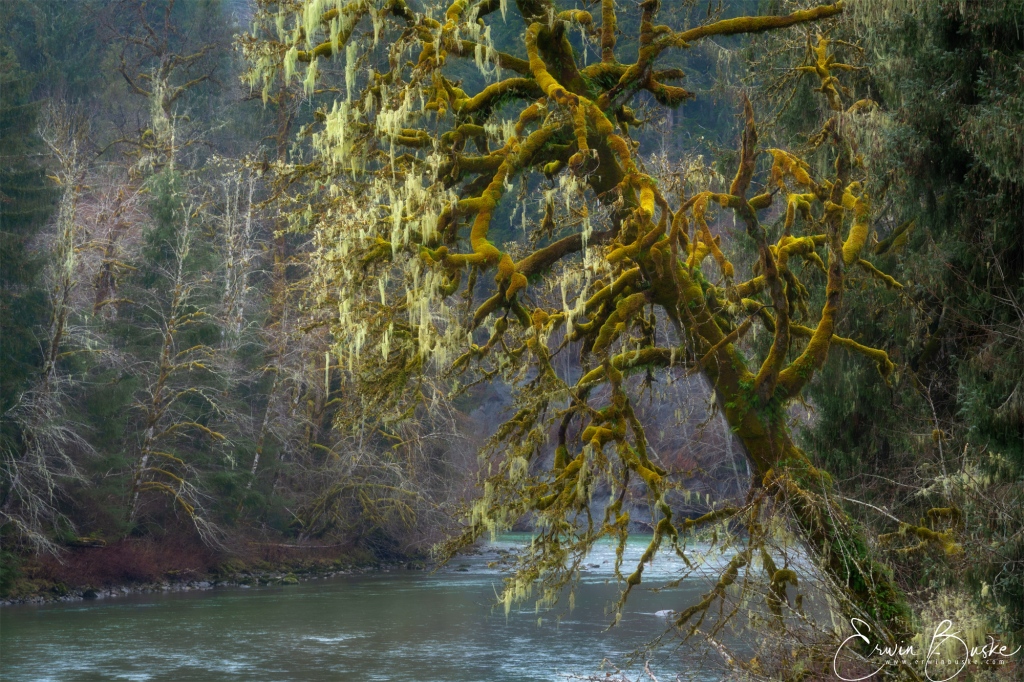
Tree Beards and Mossy Arms
I think some trees, just like people, come to life in the offseason or Winter, when we can see better their true form. With this Broad Leaf Maple Tree, we can also see its many lichen beards and moss covered arms cantilevered and spreading out over the Middle Fork of the Snoqualmie River. This scene was not part of the plan for this day and was a spontaneous discovery through a flash of perception out of the corners of my eyes. I have passed this tree countless times on my travels through the Middle Fork, but only on this day did it grab my attention. I instantly knew what to do and did not need to think through the technical details of how to create this shot. The how to was second nature to me, freeing me up to to follow the heart mind, establish a point and angle of view, and record on my camera sensor my creative vision.
Putting it All Together
Establishing a point of view, especially when combined with an angle of view, is the single most important creative decision in photography. A point of view is simply where we place our camera. Establishing the best point of view requires moving around, going this way and that. Get prepared to quickly dance. You will get a Zumba workout! Although the concept of a Point of View seems simple enough, for an image to rise to the level that is recognized as art, the point of view needs to be personally expressive in a way that also instills an emotional reaction in others. Personal expression requires that we are in touch with how nature and a landscape makes us feel. For this we must get back to more of a “Beginners Mind” that is free from preconceived notions about what is our task for the day. This does not mean we go into the field without intentions. Intentions are vital for putting the creative process in motion. The “Beginners Mind”, and the ability to pivot with changing circumstances, however, are what will ultimately lead us to the a personally expressive and unique point of view.
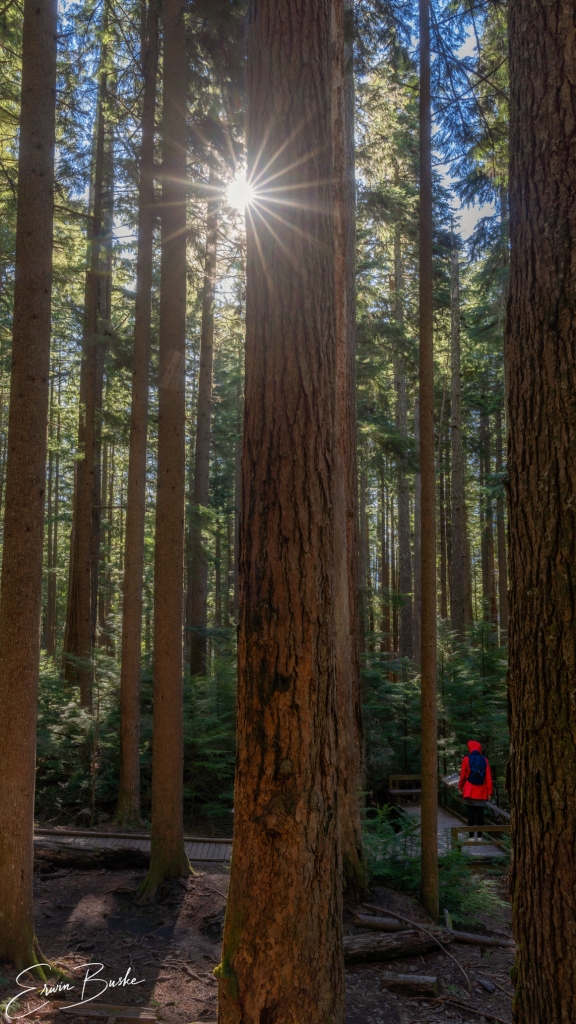
I’m Still Standing
Several of the trees in this grove (but not all) stand alone in having survived an ancient fire. Standing underneath this ancient grove and walking along the boardwalk, one feels humbled and what it means to endure in the face of danger. Establishing a point of view for this image involved use of a moderately wide angle view (27mm) and getting above the boardwalk leading to the Lady in Red. She was important in providing a sense of scale to this image juxtaposed with the sunburst at the top of the image to further enhance the sense of scale of the forest. It was important not to go too wide and not to stand too close to the forest in order to preserve the sense of forest compression.
Thanks so much for reading and viewing the images of this blog post. I encourage you to share your reactions, thoughts, comments, impressions on this post here. If you think others would enjoy reading this post, please also share it with your friends and communities. If you would like to see more content like this subscribe to the blog so you automatically receive future blog posts. To find out more about my workshops, apprenticeship, and coaching programs click here. To learn more upon my perspectives on nature be sure to check out my Ebook, the Hidden Landscape: The Inside Passage. This image rich book is 248 pages and provides insight how nature, mystery, the Tao, Zen, and the American Transcendentalism of Thoreau inform my photography and can provide sources for you own inspiration. Here is the link to the EBOOK along with a preview. https://payhip.com/b/FCI4z. Thanks again and happy trails!

Happiness is sitting on a carpet of moss in the Middle Fork valley!

Thanks for your thoughts on Point Of View, and stunning images, Erwin. I always learn something from you and think of you often, especially when I am along the Middle Fork.
Ernie Misner
LikeLike
Thanks so much Ernie. The Middle Fork is my favorite place to go to in Winter but the other seasons have their charm also. I am glad you are enjoying this wonderful place!
LikeLike